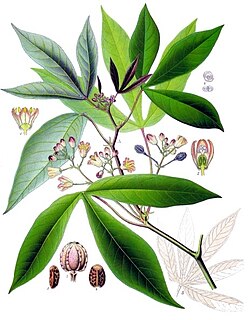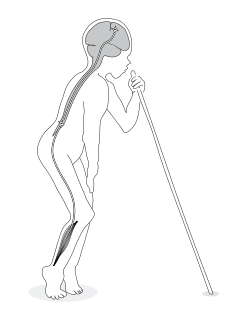Related Research Articles

Amygdalin is a naturally occurring chemical compound best known for being falsely promoted as a cancer cure. It is found in many plants, but most notably in the seeds (kernels) of apricots, bitter almonds, apples, peaches, and plums.

A cyanide is a chemical compound that contains the group C≡N. This group, known as the cyano group, consists of a carbon atom triple-bonded to a nitrogen atom.

Starch or amylum is a polymeric carbohydrate consisting of numerous glucose units joined by glycosidic bonds. This polysaccharide is produced by most green plants for energy storage. It is the most common carbohydrate in human diets and is contained in large amounts in staple foods like potatoes, maize (corn), rice, wheat and cassava (manioc).
Hydrogen cyanide, sometimes called prussic acid, is a chemical compound with the chemical formula HCN. It is a colorless, extremely poisonous, and flammable liquid that boils slightly above room temperature, at 25.6 °C (78.1 °F). HCN is produced on an industrial scale and is a highly valued precursor to many chemical compounds ranging from polymers to pharmaceuticals.

Sodium cyanide is a poisonous compound with the formula NaCN. It is a white, water-soluble solid. Cyanide has a high affinity for metals, which leads to the high toxicity of this salt. Its main application, in gold mining, also exploits its high reactivity toward metals. It is a moderately strong base. When treated with acid, it forms the toxic gas hydrogen cyanide:

Manihot esculenta, commonly called cassava, manioc, or yuca is a woody shrub native to South America of the spurge family, Euphorbiaceae. Although a perennial plant, cassava is extensively cultivated as an annual crop in tropical and subtropical regions for its edible starchy tuberous root, a major source of carbohydrates. Though it is often called yuca in parts of Spanish America and in the United States, it is not related to yucca, a shrub in the family Asparagaceae. Cassava is predominantly consumed in boiled form, but substantial quantities are used to extract cassava starch, called tapioca, which is used for food, animal feed, and industrial purposes. The Brazilian farinha, and the related garri of West Africa, is an edible coarse flour obtained by grating cassava roots, pressing moisture off the obtained grated pulp, and finally drying it.

Cellulase is any of several enzymes produced chiefly by fungi, bacteria, and protozoans that catalyze cellulolysis, the decomposition of cellulose and of some related polysaccharides. The name is also used for any naturally occurring mixture or complex of various such enzymes, that act serially or synergistically to decompose cellulosic material.

Lima bean also commonly known as the butter bean, sieva bean, double bean, Madagascar bean, chad bean, or wax bean is a legume grown for its edible seeds or beans.

A cyanohydrin or hydroxynitrile is a functional group found in organic compounds in which a cyano and a hydroxy group are attached to the same carbon atom. The general formula is R2C(OH)CN, where R is H, alkyl, or aryl. Cyanohydrins are industrially important precursors to carboxylic acids and some amino acids. Cyanohydrins can be formed by the cyanohydrin reaction, which involves treating a ketone or an aldehyde with hydrogen cyanide (HCN) in the presence of excess amounts of sodium cyanide (NaCN) as a catalyst:

Prunus serotina, commonly called black cherry, wild black cherry, rum cherry, or mountain black cherry, is a deciduous tree or shrub of the genus Prunus. Despite being called black cherry, it is not very closely related to the commonly cultivated cherries such as sweet cherry, sour cherry and Japanese flowering cherries which belong to Prunus subg. Cerasus. Instead, P. serotina belongs to Prunus subg. Padus, a subgenus also including Eurasian bird cherry and chokecherry. The species is widespread and common in North America and South America.

Beta-glucosidase is an enzyme that catalyzes the hydrolysis of the glycosidic bonds to terminal non-reducing residues in beta-D-glucosides and oligosaccharides, with release of glucose.

Alpha-glucosidase is a glucosidase located in the brush border of the small intestine that acts upon α(1→4) bonds. This is in contrast to beta-glucosidase. Alpha-glucosidase breaks down starch and disaccharides to glucose. Maltase, a similar enzyme that cleaves maltose, is nearly functionally equivalent.

Linamarin is a cyanogenic glucoside found in the leaves and roots of plants such as cassava, lima beans, and flax. It is a glucoside of acetone cyanohydrin. Upon exposure to enzymes and gut flora in the human intestine, linamarin and its methylated relative lotaustralin can decompose to the toxic chemical hydrogen cyanide; hence food uses of plants that contain significant quantities of linamarin require extensive preparation and detoxification. Ingested and absorbed linamarin is rapidly excreted in the urine and the glucoside itself does not appear to be acutely toxic. Consumption of cassava products with low levels of linamarin is widespread in the low-land tropics. Ingestion of food prepared from insufficiently processed cassava roots with high linamarin levels has been associated with dietary toxicity, particularly with the upper motor neuron disease known as konzo to the African populations in which it was first described by Trolli and later through the research network initiated by Hans Rosling. However, the toxicity is believed to be induced by ingestion of acetone cyanohydrin, the breakdown product of linamarin. Dietary exposure to linamarin has also been reported as a risk factor in developing glucose intolerance and diabetes, although studies in experimental animals have been inconsistent in reproducing this effect and may indicate that the primary effect is in aggravating existing conditions rather than inducing diabetes on its own.

Lotaustralin is a cyanogenic glucoside found in small amounts in Fabaceae austral trefoil, cassava, lima bean, roseroot and white clover, among other plants. Lotaustralin is the glucoside of methyl ethyl ketone cyanohydrin and is structurally related to linamarin, the acetone cyanohydrin glucoside also found in these plants. Both lotaustralin and linamarin may be hydrolyzed by the enzyme linamarase to form glucose and a precursor to the toxic compound hydrogen cyanide.

Konzo is an epidemic paralytic disease occurring among hunger-stricken rural populations in Africa where a diet dominated by insufficiently processed cassava results in simultaneous malnutrition and high dietary cyanide intake. Konzo was first described by Giovanni Trolli in 1938 who compiled the observations from eight doctors working in the Kwango area of the Belgian Congo.
Acetone cyanohydrin (ACH) is an organic compound used in the production of methyl methacrylate, the monomer of the transparent plastic polymethyl methacrylate (PMMA), also known as acrylic. It liberates hydrogen cyanide easily, so it is used as a source of such. For this reason, this cyanohydrin is also highly toxic.

In enzymology, a glucosylceramidase (EC 3.2.1.45) is an enzyme that catalyzes the chemical reaction

Antinutrients are natural or synthetic compounds that interfere with the absorption of nutrients. Nutrition studies focus on antinutrients commonly found in food sources and beverages. Antinutrients may take the form of drugs, chemicals that naturally occur in food sources, proteins, or overconsumption of nutrients themselves. Antinutrients may act by binding to vitamins and minerals, preventing their uptake, or inhibiting enzymes.
A great variety of cassava-based dishes are consumed in the regions where cassava is cultivated, and they include many national or ethnic specialities.

(R)-prunasin is a cyanogenic glycoside related to amygdalin. Chemically, it is the glucoside of (R)-mandelonitrile.
References
- T. Itoh-Nashida, M. Hiraiwa and Y. Uda 1987. "Purification and properties of beta-D-glucosidase (linamarase) from the butter bean, Phaseolus lunatus". Last accessed 13 November 2005.
- Heuberger, Christoph. 10 May 2005. "Physicochemical properties of cassava tubers with focus on cyanide content in fermented products". Last accessed 13 November 2005.